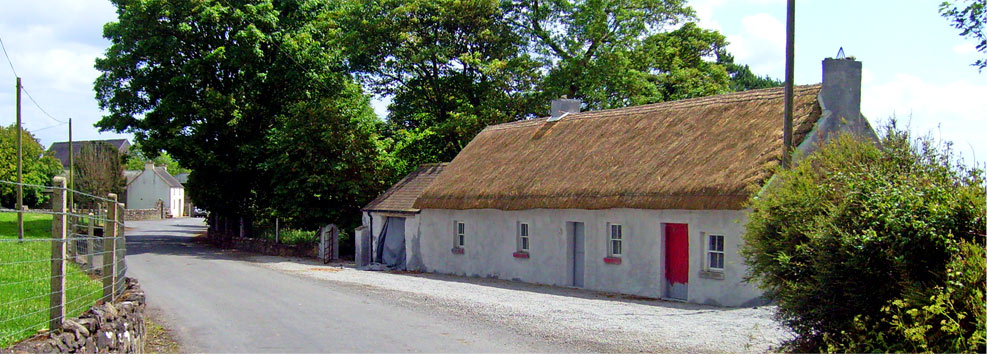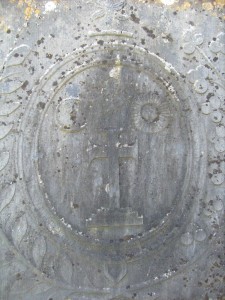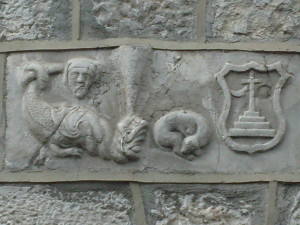© Donal G. Burke 2013
The Martin family established at Eyrecourt village by the early nineteenth century appear to have been of Galway merchant stock, where many of those bearing that name had taken a prominent role in the trade and governance of that town over several centuries.[i]
Patrick Martin of Eyrecourt and later of Lismore, parish of Clonfert, erected a funereal monument within what was then the ruins of Meelick friary church to the memory of his son Thomas who died in 1816.[ii] On the north face of the monument armorial bearings were sculpted within a wreath of leaves and shamrock, terminating at the bottom in two serpents heads. The arms appear twice on that face of the monument and are each borne upon a decorative oval and composed of a cross calvary on three grieces, above the dexter arm of which a moon in his decrement, above the sinister a sun in splendour charged with a face, in chief a mullet of eight points double pierced round encircled by six mullets of the same points pierced the same.[iii] The mullets in this case appear to represent stars given the other astronomical charges above the cross. Within a decorative ring about the oval was inscribed the text ‘sic itur ad astra’. Above the oval, as a crest, upon a wreath, is an estoile. The estoile upon a wreath appears in a number of other places upon the same monument and appears also on a keystone above the fanlight of an external door to a house associated with the same Martin family adjoining the Roman Catholic church in the nearby village of Eyrecourt.
The Martin monument below the east window at Meelick.
No tinctures were evident upon the limestone monument’s armorial bearings at Meelick and the arms displayed relating to the individuals of this particular Martin family were a variation on those often associated with individuals of the name Martin, given as ‘Azure a cross calvary on three grieces Argent, the dexter arm terminating in a sun in splendour Or, the sinister in a decrescent Argent’ and for crest ‘an estoile Or.’[iv]
While the Latin inscription surrounding the oval complimented the use of the stars in these arms and was by coincidence apt in this context for its association with a journey heavenward, the motto ‘sic itur ad astra’ was used by certain branches of the name Martin. The most commonly recognised motto of individuals of the name Martin was ‘auxilium meum a Domino’ but Robert Martin of Ross House, near Moycullen, Co. Galway, born in 1780, of a family seated at Ross since at least the late sixteenth century, bore for arms ‘Azure, a calvary cross Argent, between the sun in splendour on the dexter limb Or and the moon in crescent on the sinister of the second’, with a crest of ‘an estoile wavy of six points Or’ with the motto ‘sic itur ad astra.’[v]
Tradition ascribed the granting of these arms by King Richard I of England to one Oliver Martin, reputed to have been the progenitor of the Martin family of Galway and to have been granted unto him by the king in the Holy Land during the crusades.[vi] A similar tradition held that the same king granted arms to an ancestor of the Burkes during the crusades. The latter tradition appears to have been unlikely and it is likely that the tradition in relation to the Martin arms is a later creation. Similarly by tradition the arms of the Lynches, prominent in the town of Galway, were supposedly given them in recognition for an ancestors defence of the town of Lintz in Austria before the time of King William I of England, a story that may be discounted, not least given the undeveloped nature of personal heraldry at that time.[vii]
Various armorial stone tablets and marriage commemoration tablets relating to individuals of the name Martin survived in the older districts of Galway City into the early twenty-first century, the majority dating from about the seventeenth century. Among these carvings are a number of variations in the placement of the sun and crescent charges. The arms associated with other Galway merchant families of ffrench and Bodkin were carved, together with those of Martin, below a closed helm in profile, on a chimneypiece dated 1612 in a building situated on High Street in Galway City.[viii] On this piece the Martin arms were displayed on the sinister half of the shield and consist of a cross calvary of five grieces with a sun in splendour below the dexter limb and a moon in her decrement under the sinister.[ix]
Another stone, located on the remains of a building on Shop Street in that city, carrying a date in the 1630s and the impaled arms of a member of the Athy family and his wife of the Martin family, displays on the sinister side arms composed of a cross calvary on four grieces and below the dexter arms a sun in splendour and below the sinister arm a decrescent.[x] Two separate armorial carvings at high level on buildings along Flood Street in Galway city give a variation on this, both of which may date stylistically from about the fifteenth or sixteenth century. One gives a cross calvary but with limbs of a latin cross atop four grieces and below the dexter limb a crescent and below the sinister a sun in splendour. The second, on an adjacent building, displays the arms with a dominant cross calvary with limbs of a cross Moline, pierced as a diamond in the centre, and splayed at base atop three grieces, with, below the dexter limb, an increscent and below the sinister a sun in splendour.
Flood Street, Galway City.
Flood Street, Galway City.
Christopher Bernard Martin of Eyrecourt, brother of the Thomas Martin commemorated by his father in this monument at Meelick, was the principal contributor to the construction of the Roman Catholic church erected in the village of Eyrecourt in the early nineteenth century.
[i] Hayes-McCoy, M., The Eyre Documents, JGAHS, Vol. XXI, p. 82. Christopher Bernard Martin, ‘the eldest son and heir of Patrick Martin, late of Eyrecourt and now of Lismore, County Galway’ was given as party to a deed relating to premises in Galway town at the Fishmarket and New Cross Street, among other transactions.
[ii] ‘This monument was erected by Patrick Martin esq. of Lismore to the memory of his beloved son Thomas Martin who departed this life in Dublin on the 7th of September Anno Domini 1816 in the 25th year of his age. O Lord have mercy on his soul.’ This monument straddled the remains of the original east gable of the friary church. On the later reconstruction of the church the new east gable was erected to the west of this monument, leaving this monument and part of the adjacent Moore family vault outside of the church proper.
[iii] Franklin, J., Shield and Crest, an account of the art and science of heraldry, MacGibbon & Kee, London, 1967, p. 230-232. While ‘a moon in her decrement’ is the suggested wording for such a charge, the gender of the face in both the moon and the sun in splendour on this monument is male, both appearing to have a bearded chin in addition to a prominent fringe.
[iv] Ó Comáin, M., The Poolbeg Book of Irish Heraldry, Poolbeg Press, Dublin, 1991, p. 162.
[v] Burke, B., A genealogical and heraldic dictionary of the Landed Gentry of Great Britain and Ireland, Harrison, London, 4th edition, Vol. II, p.982-983.
[vi] Burke, B., A genealogical and heraldic dictionary of the Landed Gentry of Great Britain and Ireland, Harrison, London, 4th edition, Vol. II, p.982-983. Sir Bernard Burke refers to this tradition in relation to Oliver Martin having been recorded in ‘the Book of Pedigrees’, Vol. X, in the then Office of Arms at Dublin Castle.
[vii] Hardiman, J., The history of the town and county of the town of Galway, from the earliest period to the present time, W. Folds and sons, Dublin, 1820, footnote, pp. 17-18.
[viii] This building would later become a public house, known in the twenty-first century as ‘The King’s Head’.
[ix] O Dowd, P., Old and New Galway, Archaelogical, Historical and Folklore Society, R.T.C.,Galway & the Connacht Tribune, Galway, 1985, p.121.
[x] O Dowd, P., Old and New Galway, Archaelogical, Historical and Folklore Society, R.T.C.,Galway & the Connacht Tribune, Galway, 1985, p.113.






